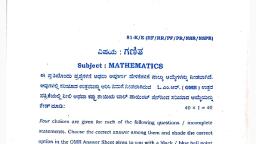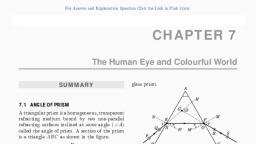Page 1 :
Govt PU College, High School Section, Megaravalli, Tirthahalli Tq, Shivamogga Dist., Date : 28/6/21 Chapter 10: Light reflection and refraction. Total marks- 15, , 1.One of the effects of refraction among the following is, (A)Formation of image in a mirror, (B)Appearance of flowers in different colours, (C)The sky appears blue in colour, (D)The pencil immersed in water appears to be bent, , 2. The focal length of a spherical lens is, (A) the distance between optical centre and principal focus of the lens, (B) the distance between centre of curvature and optical centre of the lens, (C) the diameter of the outline of spherical lens, (D) the radius of the outline of spherical lens., , 3.Which one of the following materials cannot be used to make a lens?, (A) Water (B) Glass (C) Plastic (D) Clay, , 4.Where should an object be placed in front of a convex lens to get a real image of the, size of the object?, , (A) At the principal focus of the lens, , (B) At twice the focal length, , (C) At infinity, , (D) Between the optical centre of the lens and its principal focus., , 5. Which of the following lenses would crime investigator prefer to use while searching, for finger prints on the spot of robbery., (A) A convex lens of focal length 100 cm, (B) A concave lens of focal length 100 cm, (C) A convex lens of focal length 10 cm, (D) A concave lens of focal length 10 cm, , 6. A doctor prescribes a corrective lens of power +0,25D to a person. The focal length of, lens and the type is, , A) +4m and convex lens B) -2m and convex lens, C) +4m and concave lens D) —4m and concave lens, 7. The position of the image obtained by a convex lens when an object is kept at F,,, A) at 2F; B) at FP», C) beyond 2F) D) at infinity, , 8. The phenomenon of bending of light as it passes from one transparent medium to, another is, , A) refraction of light B) reflection of light, C) internal reflection of light D) lateral inversion of light
Page 2 :
9. The magnification of the image formed when the object is kept between the principal, focus ‘FI’ and optical centre ‘O° of a convex lens is, , A) equal to 1 B) more than |, C) less than | D) equal to | or less than |, , 10. The diameter of the circular outline of a spherical lens is, A) optical centre B) centre of curvature, C) aperture D) principal axis, 11. Object distance and image distance of a lens are —30 cm and -10 cm respectively,, then the magnification of lens will be, , A)-0.33 B)+3.0, C) +033 D)+4.0, 12.Refractive index of four medium A, B, C and D are 1.31, 1.65, 1.44 and 1.50, respectively. The velocity of light is minimum in, (A) medium B (B) medium D, (C) medium C (D) medium A,, , 13. Light enters from air to glass having refractive index 1.50. What is the speed of, light in the glass if thehe speed of light in vacuum is 3 « 10% m s~!?, , (A) 2.5 x 10°m/s (B) 1.5 x 10%m/s (C) 2x108m/s = (D) 3x 10°m/s, , 14. To determine the approximate value of the focal length of a given concave mirror, you, focus the image of a distant object formed by the mirror on a screen. The image, obtained on the screen, as compared to the object is always :, , (A) Laterally inverted and diminished (B)Inverted and diminished, (C) Erect and diminished (D)Erect and highly diminished, , 15. Identify the emergent ray in the given figure., , A)CD, B) EI, C) AB, , D) Ty., , , , , , , , , , , , Raghavendra Bhat — 9483810224














































